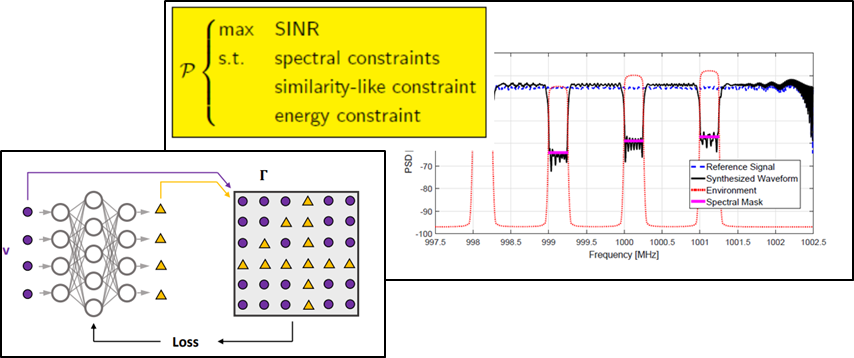MSc thesis project proposal
[New!] Cognitive Radar: Semidefinite Programming Waveform Generation using Neural Networks
Semidefinite programming (SDP) is a subset of convex optimization problems that can be applied to many radar problems. However, they are slow to solve, but in many cases fast solvers are needed for pseudo-real-time applications. Some studies have used neural networks as surrogate models to solve an arbitrary SDP problem, but the connection with radar application has not been investigated in the literature.
In this MSc thesis, the use of neural networks to solve SDPs for radar waveform design is studied. Specifically, we want to design radar waveforms that can operate well in a congested electromagnetic environment where other emitters are operating (e.g. radio communications or mobile phones), without mutual destructive interference. This project is in collaboration with the group of Prof A. De Maio at the University Federico II of Naples, one of the world-leading groups in radar signal processing.
Assignment
As a starting point, you should understand and implement the generic framework explained in [1] and then adapt it to solve the SDP described in [2]. The goal is to use the neural network to generate the baseband IQ samples of the desired waveform, placing notches at those frequency bands where interference is detected.
First, the problem will be solved with simulated data, generating in MATLAB the interference signal and evaluating the performance in terms of radar detection capabilities. Then, once a neural network is trained, the system will be tested with experimental data using the PARSAX radar on the roof of our faculty building.
[1] Kriváchy, T., Cai, Y., Bowles, J., Cavalcanti, D., & Brunner, N. (2020). Fast semidefinite programming with feedforward neural networks. 1–10.
[2] Aubry, A., Carotenuto, V., & Maio, A. De. (2016). Forcing multiple spectral compatibility constraints in radar waveforms. IEEE Signal Processing Letters, 23(4), 483–487.
Requirements
For this project you have some background in radar signal processing and machine learning, and preferably in optimization approaches. Moreover, you are comfortable coding in Matlab for the signal processing part and in Python/Matlab for the neural network part.
Since this is a really hot topic in the research community, this work can potentially lead to a publication in a conference or journal.
Contact
dr. Francesco Fioranelli
Microwave Sensing, Signals and Systems Group
Department of Microelectronics
Last modified: 2025-02-11
